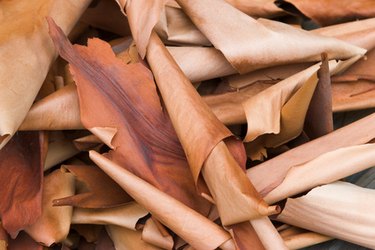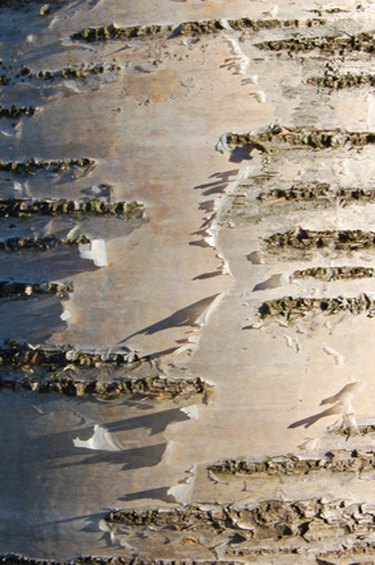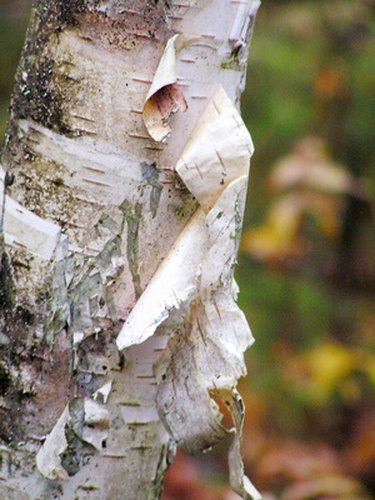
Madrone trees belong to the genus Arbutus, with over a dozen species worldwide. There are six North American species of arbutus, commonly called madrones. The Pacific madrone, Arbutus menziesii, is known as madrona. Madrones are shrubs or small trees with leathery leaves, edible red berries, reddish-brown wood and flaking red bark. Madrone peeling bark can be very dramatic, like someone ripping wallpaper off. There are current health concerns about some madrone species, but shedding bark is a natural process.
Why Trees Have Bark
Video of the Day

A tree grows up by growing new stems from tips of branches. It grows wider by growing cells outwards from the center. Sap and nutrients circulate inside the trunk; the bark is a layer of dead cells which protect the living wood. This is similar to the way human skin grows from the inside and is a dead protective layer on the outside. Bark not only protects the living wood from damage, it reduces evaporation of water from the inner tree. Tree bark becomes hardened as it ages; as the tree slowly increases in girth the bark tends to split vertically, horizontally or into plates.
Video of the Day
Exfoliating Bark

There are many different types of bark, from thick plates to thin paper, depending on the tree species and how it evolved in its native location. All of them are prone to cracking as the tree grows, and in some species a form of sunburn occurs in which the bark peels from over-exposure to heat. However in certain species the bark peels off naturally to expose new bark underneath. Some trees do this periodically, like snakes shedding their skins, and some species constantly shed bark. Madrones shed their bark quite aggressively.
There is debate about the purpose of "exfoliating bark" (the biological term).The most commonly accepted theory is that it's an evolutionary development which helps the tree shed lichens and parasites such as boring insects, which lay their eggs on the bark. By shedding its bark the tree prevents their buildup and reduces the chance of disease. This is common in tropical areas where there are numerous fungi and aerial plants.
Trees With Peeling Bark

There are a number of trees which have naturally peeling bark. Birch and cherry have paper bark, and birch often peels. Crape myrtles, the paper bark maple and certain types of sycamore or plane trees do also. Paper bark varieties are often selected by landscapers to add interest to gardens in winter. Madrones are notable for their beautiful red wood and peeling bark, which is natural to the species rather than being a special variety bred for gardens. Wild madrones in forests look the same as madrones in gardens.
Madrone Health

The Pacific madrone is currently in decline, a cause of much concern. In the Northwest, madrona grows intermixed with Douglas fir and regenerates after forest fires; fire suppression may be one cause of its decline. Madronas are also sensitive to drainage and environmental conditions, and tend to become diseased when under stress; they are susceptible to a type of sudden oak death. These conditions can be seen in spotted, withered or blackened leaves. However, peeling bark is not usually associated with infection; it is part of the normal growth of madrone trees.